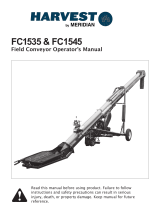SKANDIA ELEVATOR
Your conveyor system must be assembled correctly and maintained
thoroughly if it is to operate satisfactorily. These maintenance instructions and
the separate assembly instructions for each machine must be followed for the
warranty to apply.
We hope you will be pleased with your Skandia conveyor equipment for a long
time.
Thank you for choosing Skandia Elevator!
Contents
Safety information ...................................................................................................................4
Safety decals ....................................................................................................................................................................6
Maintenance ...................................................................................................................................8
General ...................................................................................................................................................................................8
Bearings .................................................................................................................................................................................8
Return rollers chain conveyors / Belt conveyor carrying idlers,
return idlers, snub idlers and tracking idlers ...............................................................................8
Belt conveyor return idlers, snub idlers, tail pulley and drive pulley ..............14
Transmission .....................................................................................................................................................................8
Conveyor chain ...........................................................................................................................................................10
Conveyor belt ................................................................................................................................................................12
Forward driving end, sweep conveyor ...............................................................................................14
Troubleshooting ...................................................................................................................... 16
Poor capacity/stop ................................................................................................................................................. 16
Machine noisy .............................................................................................................................................................18
Plastic ight bends ................................................................................................................................................. 18
Lid/bottom plate in bend section gets warm ...........................................................................19
Motor stoppage ..........................................................................................................................................................19
Belt conveyor misalignment ........................................................................................................................19
2-3 way valve leaking ..........................................................................................................................................19
Technical specications ............................................................................................... 20
Geared motor rating plate .............................................................................................................................20
Density table .................................................................................................................................................................20
L-Line .....................................................................................................................................................................................21
I-Line ..................................................................................................................................................................................... 22
H-Line ..................................................................................................................................................................................23























